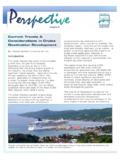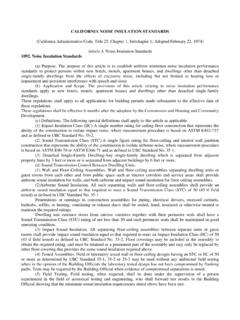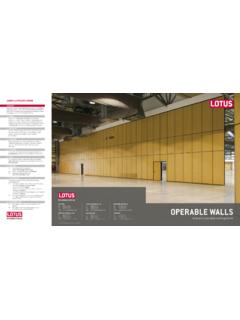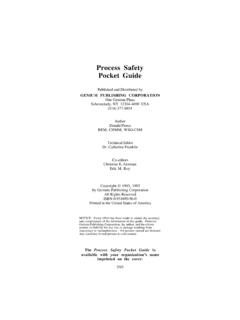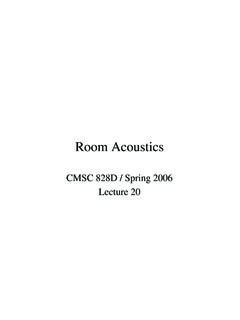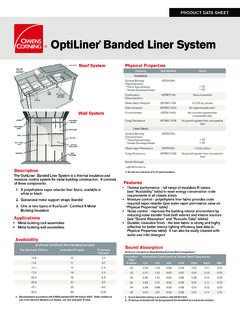Transcription of Evaluating the Condition of Seawalls/Bulkheads
1 By: Coastal Systems International, and bulkheads (walls) provide shorelinestabilization for many coastal and waterfrontproperties throughout Florida and walls provide an economicalapproach for vertical shoreline stabilization,allowing owners to maximize upland propertyarea, as opposed to other shoreline stabilizationmethods such as revetments or natural wet-lands/mangroves. Existing walls were construct-ed of many different structural configurations,and at various time periods. Coastal and water-front properties are in high demand in SouthernFlorida and the Caribbean with an increasingcoastal population. Developers and propertyowners are looking to rehabilitate existing prop-erties, and the Condition of a coastal seawall orwaterfront bulkhead can significantly impact thetotal cost of property development. Also, manywaterfront property owners may have experi-enced problems with their existing structures, orhave concerns regarding the structural integrityof their perspective will explain:Typical bulkhead under constructionTypical coastal seawallEvaluating theCondition of Seawalls/Bulkheads Difference between Seawall & Bulkhead Introduce Elements of Wall Design Present Materials of Construction with a Discussion of Material Performance Address Special Regulatory Issues with seawalls Discuss Wall Structural Evaluation Methodology Present Frequently Asked Questions Regarding seawalls and BulkheadsVolume Concrete BulkheadMany people refer to all vertical shorelinestructures as seawalls , but there is a differ-ence between a seawall and a : structure that provides shorelineprotection from waves but also retains.
2 Vertical shoreline stabilizationstructure that primarily retains soil, and pro-vides minimal protection from are typically located on the coastfronting beaches, and are subject to stormsurges with pounding surf, eroding shorelinesand wave overtopping from coastal stormevents. Some localized waterfront propertiesmay be subject to significant wave activity,even though they are not exposed to oceanwaves. A coastal engineering study can pro-vide seawall design information to ensurethat they are designed properly to withstand the dynamic loading and overtopping effectsof waves. The rule of thumb in bulkheaddesign is to account for wave impacts if thesignificant wave height at a project site isexpected to be in excess of three feet (1meter). Unfortunately, many existing walls onthe coast were simply designed as bulkheads ,and did not account for coastal oceanfront seawallCross-section of typical seawall: Note use of boulders against wave overtoppingTypical bulkhead cross sectionElements ofWall DesignPrior to Evaluating a bulkhead or seawall, thefollowing design considerations need to beaddressed to be able to properly assess : elevations, grading, Properties: unit weight of soil, clayvs.
3 Sand, : depth of wall forstabilityWater Table: differential water levels behindand in front of walls can introduce additionalloading on the wallWall Material Properties: strength and per-formance in the marine environmentSurcharge: live loads behind the wall such asvehicles These additional design considerations needto be addressed for seawalls : Wave Forces Toe Scour Wave Overtopping Storm SurgeIf a wall is damaged or deteriorated, the orig-inal design may not have accounted for theabove-listed design considerations. Originalor as-built plans can provide a wealth ofinformation including the age of the structureand many of the design elements listed in theabove paragraphs. The deteriorated conditionof a wall may also be an indication that thewall is in need of maintenance, or that it hasfulfilled its service life. Failed bulkhead due to inadequate embed-ment of concrete pile/panel storm sewer outfall through ofConstructionSeawalls and bulkheads are constructed ofsimilar materials.
4 The material of the wallmust be properly identified prior to assessingthe Condition . The following table presentscommon wall construction materials with comments regarding availability, constructionissues, and general performance in themarine environment:Pile/panel and sheet piling configurationscommon in South Florida. Most commonwall material in South Florida due to thelocally available aggregate; providesservice life of 30+ years if correct mixdesign and proper marine structural design sheet piling commonly used forbulkheads/ seawalls . Material providesexcellent strength characteristics forhigh wall exposure applications. Providesinterlocking seal, and generally easy toinstall, even in harder substrate. Mustbe properly coated and maintained forlong service life of 25+ piling provides good corrosionresistance, but lighter sections allow forminimal exposed wall height. Recognize corrosion potential of dissimilar metalhardware, do not use in waters with lowPh or backfill with clay-mucky soils.
5 Difficult to install in hard often used in South Florida, butoccasionally seen on inland pile/wale/sheet system is com-mon structural configuration. Generallyeconomical material, but limitedstrength characteristics for high wallheights. Preservative treatment is essen-tial for marine organisms. Difficult toinstall in hard new economical product withservice life of 50+ years. Available indifferent colors. Limited strength cha-racteristics for wall heights. Difficult toinstall in hard substrates. Material CommentsConcreteSteelAluminumTimberVinyl /PlasticDamaged timber seawallTypical vinyl sheet pile bulkhead (Picture cour-tesy of Materials International)Seawall - DEPR equirementsSeawalls on the coast of Florida come underthe jurisdiction of the Florida Department ofEnvironmental Protection (DEP). In additionto Evaluating the structural Condition of aseawall, the DEP has special requirementsfor seawalls at or near the Erosion ControlLine (ECL). A coastal engineering analysis isrequired to determine if an existing seawallwill be affected by a 30-year coastal stormevent.
6 If the existing wall is within the 30-year Erosion Projection, then the property owner must provide scientific and engi-neering evidence that the armoring struc-ture (seawall) has been designed, construct-ed, and maintained to survive the effects ofa 30-year storm and provide protection toexisting and proposed structures from theerosion associated with that event. The DEPrequires certification by a professional engi-neer that the seawall was designed, con-structed, and is in adequate Condition tomeet the following criteria:1. The top of the seawall must be at orabove the predicted maximum wave crestelevation, considering the eroded beach pro-file, of the 30-year design The seawall must be stable under the 30-year design storm including localized scour,with adequate penetration and toe protec-tion to avoid settlement, toe failure, or lossof material from beneath or behind The seawall must have sufficient continu-ity or return walls to prevent flanking underthe design storm from impacting the pro-posed The seawall must withstand the static andhydrodynamic forces of the 30-year American Society of Civil Engineers (ASCE)Underwater Investigations Standard PracticeManual was released in 2001 and provides guid-ance for the evaluation of walls.
7 Procedures arealso applicable for above-water structures. Mostbulkheads are along the waterfront, and shouldbe evaluated above and below the water, where-as seawalls typically are not exposed to water ona regular following topics are covered related to struc-tural bulkhead/seawall evaluation: Qualifications of Inspection Personnel Types and methods of inspections Typical forms of deterioration Condition Rating Frequency of Inspection A comprehensive report is essential to documenta proper bulkhead or seawall evaluation. All ofthe above items should be included along withphotographs and sketches of the observed con-figuration with notes regarding of previous reports provides an indi-cation of the rate of engineering analysisRepair recommendations, along with con-struction cost estimates, should be includedto provide the property owner with soundengineering advice so they can plan for main-tenance or repairs as necessary. The reportshould be sealed by a registered professionalengineer experienced in the evaluation of in-service marine Regarding bulkheads and SeawallsCan I raise the grade of my property with the existing bulkhead?
8 The bulkhead must be evaluated by an engi-neer to determine if the structure can with-stand the additional loads from fill and struc-tural modifications. Deterioration can severelyweaken the structural capacity of the bulk-head, and the bulkhead was most likelydesigned for the existing is the best material for bulkheads and seawalls ? Material selection is site-specific and depend-ent on design conditions . Concrete (ifdesigned appropriately) generally provides along service life, but it is not favorable from afirst-cost basis. Vinyl sheet piling and othercomposite materials, where applicable, shouldbe considered due to their resistance to theharsh marine environment and 50+ yearservice long can I expect my wall to last?Answers to this question are generally subjec-tive. An experienced marine structural engi-neer can provide general assumptions as tothe expected remaining service life of amarine structure. Comparisons with observeddeterioration over time can also provide anindication of material performance.
9 Certainnon-destructive and/or partially destructiveExploratory excavation to evaluate Condition ofthe tie photograph of steel sheet pilingmaterials testing can provide additionalinformation for the regulatory permits are required? bulkheads typically require an environmentalresource permit from several agenciesincluding the county environmental resourcemanagement agency, the DEP, and the Corps of Engineers. Depending on thejurisdiction, the local water managementdistrict may also issue a permit. Seawallsrequire a permit generally from the stateagency such as the often should I inspect the wall?The ASCE Manual provides guidance for thefrequency of inspections. Generally, seawallsand bulkheads should be evaluated every 5to 6 do I repair my wall?A qualified marine structural engineer shouldbe consulted to evaluate the existing walland to determine if rehabilitation or replace-ment is required. Options can generally beprovided to provide an economical approachto meet budget can build a wall?
10 Marine structures are specialized structures,often requiring water-based constructionequipment and techniques. The costs forwaterfront construction are generally higherthan for upland structures such as or seawall work should be reservedfor a qualified and experienced marine There is a difference between a bulkheadand a Bulkhead and Seawall design is site-specific and the design elements of a particular structure should be understood priorto Bulkhead materials of construction exhibit various forms of deterioration in the marine environment. Proper material identification is essential to assess structural seawalls in Florida come under the juris-diction of the DEP, and require coastal engineering studies to assess predicted ASCE recently released a standard practice manual to provide guidance for the above/below water assessment of marine Bulkhead and seawall evaluations should be conducted by qualified personnel under the supervision of a licensed professional , W.
